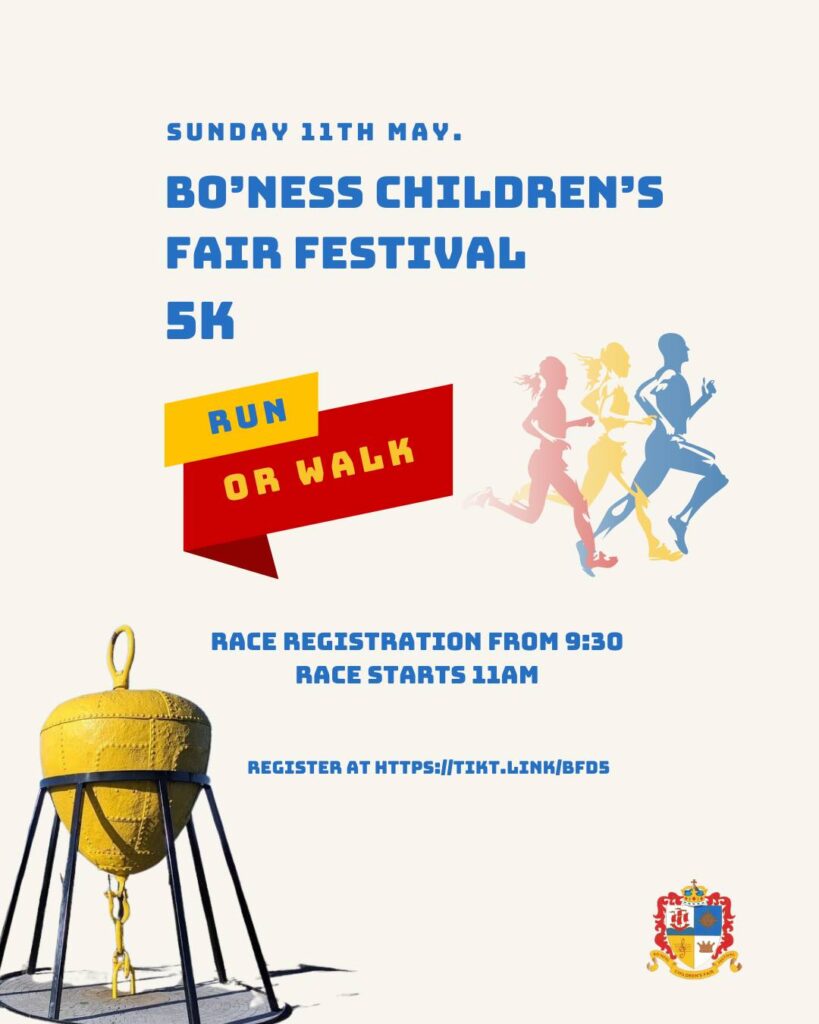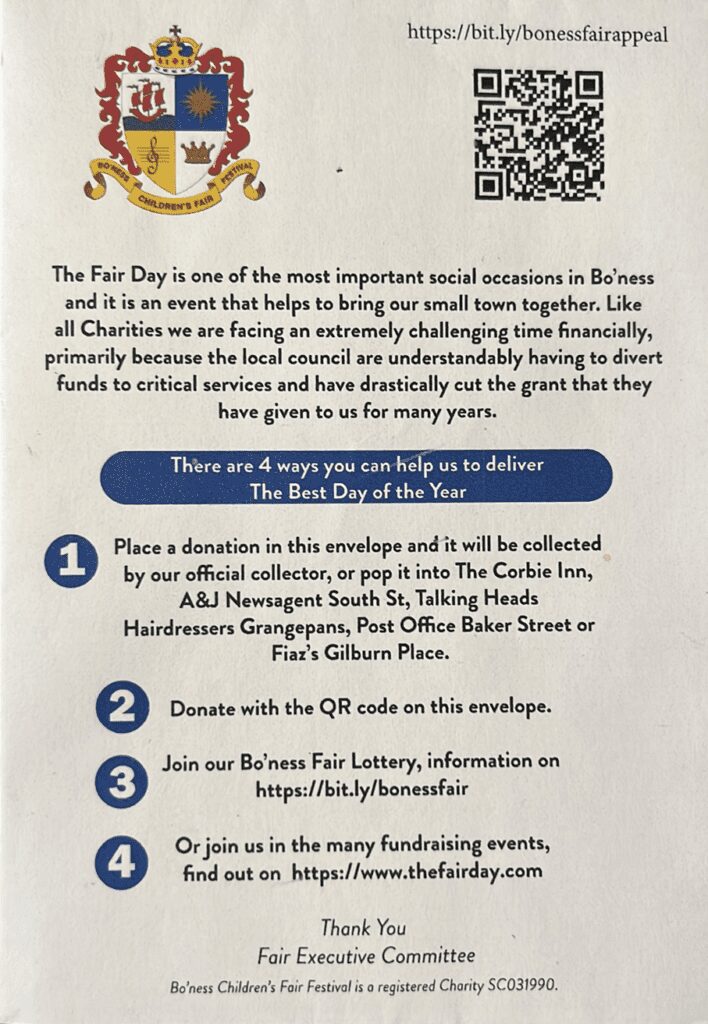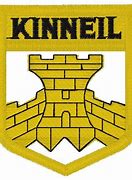Sceptics have often suggested that the letters O.B.E. may possibly have another meaning apart from the official order of the British Empire. Bo’nessians now know that they undoubtedly have, because when our former Provost, Vice Convener of Central Region Councillor Charles Snedden received the O.B.E. in this year’s New Year’s Honours List, Her Majesty was obviously very well aware of his ” Outstanding Bo’ness Efforts.”
This , therefore, will be a particularly proud Fair Day for Charlie, because there is no Bo’ness event for which he has in the past worked harder. Charlie Snedden is indeed the best possible example of the traditional Fair ” hand,” a Bo’nessian, born and bred, for whom the Fair is as vital as the very blood in his veins. It is equally impressive this year with our Fair Queen coming from Deanburn Primary School, that it is the Fair which has caught so many of the new families who have come to live in our town with its web of magic fantasy and done more than anything else to integrate these newcomers into the community.
It was in 1974 that the brand new Deanburn Primary, set high on its hill above Kinneil House looking out over the magnificent sweep of the River Forth and the Fife hills beyond, first provided our Fair Queen and so rapidly do the years pass that it is very hard to realise that when Alison Cross is crowned in Glebe Park on Friday, 29th June, she will be the school’s third Queen.
Deanburn’s first Fair, when Linda Dow was the pupils’ choice as Queen will always be remembered, not just because her coronation was filmed and preserved for posterity by well-known Scottish producer Mike Alexander, but also because of all its innovations, its new-style costumes and its heralds, who because of the school’s excellent brass band, were well able to play their own fanfare.
Ten years later enthusiasm for the Fair at Deanburn is as great if not greater than ever and Headmaster Jim Vallance reports that there was tremendous friendly rivalry amongst all of his pupils for the leading roles, with some of the girls even querying whether in these days of women’s ” lib ” and no sex discrimination there could possibly be girl heralds? So great too was the demand from boys in the Primary 7 classes to be involved in the Fair that Mr Vallance has managed to persuade the Fair Committee to allow him to create them Queen’s Escort so that they would not be disappointed, and so yet another Deanburn innovation will be seen when they parade carrying their banner in this year’s procession.
It is great to know that in these days of expensive computers for Christmas that the Fair still remains just as important an event in the lives of our children as it did when I was a child.
I was one of the unfortunate wartime youngsters who had to wait impatiently until 1946 to see my first Fair, but even during the years of the hostilities the Fair was never forgotten and the continued teaching of the Fair songs in the schools and participation in ” Wee Fairs ” during the summer holidays simply whetted our appetites for the real thing.
And I wasn’t disappointed when on a July Friday morning in 1946 I awoke to all the excitement of my first Fair. There was absolutely no doubt about the importance of this day, for already the big Union Jack, the same one with which we had celebrated both V.E. Day and V.J. Day the year before, was poking out of the front bedroom window of “Hallcraig” as I rushed to catch a glimpse of the first of the bands marching along Dean Road.
Despite clothes rationing there was a brand new white school shirt waiting to be put on, along with carefully pressed grey flannel shorts and the scarlet tie and scarlet cap for Bo’ness Public and as soon as I was dressed I was all for marching after the band, but my mother insisted as mothers do on breakfast first.
Even such a mundane matter as breakfast, however, had a special excitement on that Fair morning, because when I heard the whistle announcing the arrival of the Co-op car and dashed out to buy milk, rolls and my favourite bran scones, I discovered to my delight that our milkman, Mr Auld, had decorated his patient horse Pearl as I had never seen before. Her black leather harness fairly gleamed and both her mane and her tail were carefully plaited with straw and interwoven with red, white and blue ribbons, and in that instant I realised for the first time the meaning of that well-known Bo’ness saying, ” All dressed up like a Fair horse.”
There were more Fair horses, when breakfast was over, to my mother’s satisfaction. I clutched my father’s hand and together we made our way along to the Chance Park, all three sides of whose triangle were lined with what to my child’s eyes seemed the most wonderful decorated carts. There was Stewart of the Drum’s cart with its big red wheels and the Store’s bread float of green, closed-cropped boxwood, and Spowart’s junk cart completely transformed from its workaday role, and what seemed dozens more, certainly completely out-numbering the few decorated motor lorries, which were no doubt in short supply because of the petrol shortage.
There was also a shortage of time, because my father had strict instructions to have me back home ready for school, but even that prospect had its excitements for our teacher had promised that as well as our usual third pint bottle of milk with its cardboard top, complete with hole for a straw to go through, we would each receive a real banana, and I had never before unzipped, far less eaten, a banana.
Across in the Glebe Park we could hear the crowds assembling and the band playing in the band stand and a voice crackling on the tannoy ( would it have been that Johnnie Collie?) and it seemed an absolute age before our headmaster Mr Sleath gave the command and we all marched off, four abreast up the steep School Brae.
Miss Livingston fussed over the fairies and the flower girls, each with their Public School scarlet carnations and Miss Miller even designed to smile as we rounded the corner at the top entrance to the Glebe Park and saw spread out before the coronation platform. After the longest hibernation in its history Bo’ness Fair had awoken to the new post-war world.
These may still have been rationing and all kinds of shortages, but mothers had worked wonders and to my eyes it was everything that I had always been promised the Fair would be, with the heralds delivered their time-honoured proclamation, the champion, his traditional challenge, and best of all, oh definitely best of all the Fair songs. We had practised them before, but now we were singing them for real. Then as hands of the big Town Hall clock touched 11 o’clock, Sadie Potter, from Grange School, was crowned and Bo’ness had a Queen again.
The following year there was even more excitement because the Fair was from the Public and I still remember tearing home up Darien Lane and Marchlands Avenue to be the first with the news that the Queen was to be Mary Sneddon from Newtown. That meant, of course, that the Queen’s arch was just round the corner from my home and again I remember the thrill of watching it being raised into position and how splendid it looked towering over Cadzow Avenue.
Queen Mary was succeeded by Queen Jeanette, from St. Mary’s, and then Queen Margaret, from the Academy, but it was the next Queen from the Academy. Mary Gibson, who was crowned in 1954 that I remember best for by then I too had moved on from the Public to the big school. My cousin Jean was one of the August Seniors who sailed past us in the corridors and were allowed the privilege of entering by the main door in Academy Road. She was chosen to be one of Queen Mary’s ladies-in-waiting and so there was all the family involvement of building an arch and the pride of winning a prize for all our work.
At school, too, there was the excitement of decorating the front of the building with banners in red, black and gold. The school colours which we were proud to wear and the fun of trying to lower a massive shield with the school badge and motto ” Sine Metu ” from Mr Gould’s art room window. Under his stern but benevolent eye we at last managed it and by the Fair morning all was in position for Queen Mary to make her dignified appearance. I’ll never forget how proud our new rector Alan McIntyre, Andrew Dea’s young successor, looked as he led his first and only Queen to her open horse-drawn landau. Little did we realise on that Fair morning how short a time we were to enjoy his leadership and guidance before his untimely and all too early death.
That Fair in 1954 was the first time that there was any question of the Academy senior pupils fulfilling their customary roles in the coronation ceremony. Voting was delayed for a week, but Alan McIntyre’s diplomacy paid off. Queen Mary and her courtiers carried off their duties to the manor born and Academy Fairs continued for another 15 years until, in 1969, Kathleen Wildman became the last of the line which had begun in the very first year of the Fair in 1897 with Queen Grace Strachan.
I still believe that an Academy Fair had a style all of its own, but days have changed and I welcome the new ways in which the Academy’s pupils have found to contribute to the proceedings from their lively decorated floats to collecting along the procession route for various charities and to the article on the history of the Fair, which an Academy senior has written specially for this magazine.
So long as that interest remains our Fair is safe.
WILLIAM F. HENDRIE






